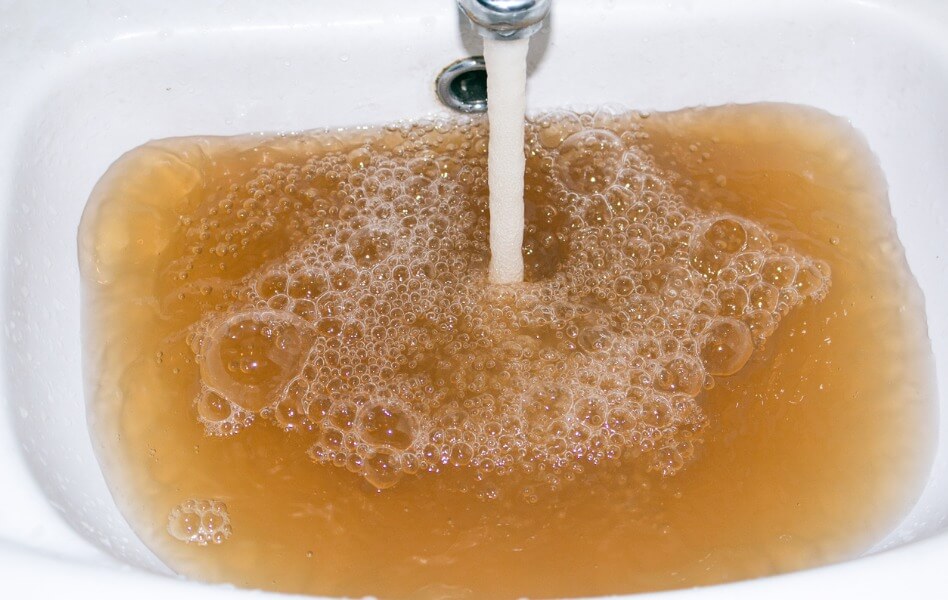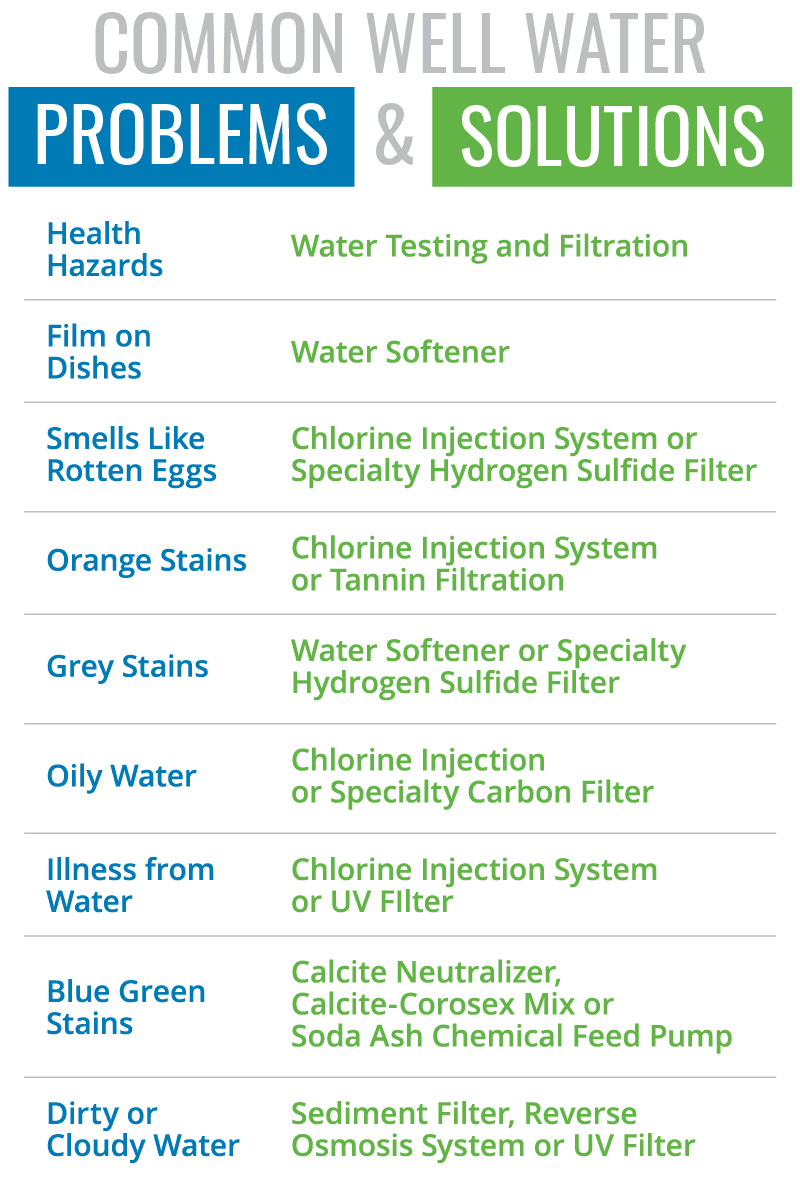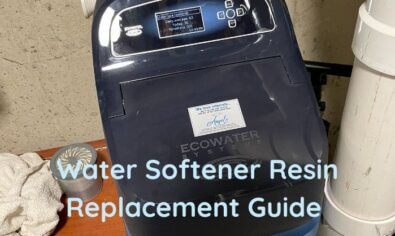9 Common Well Water Problems and How to Easily Solve Them
In this blog, you will learn:
There are many common well water problems, including film on dishes, orange stains and oily water.
The cause of these common problems include hard water and contaminants like iron and hydrogen sulfide.
You can solve these problems with water treatment equipment, such as reverse osmosis systems, chlorine injection systems and carbon filters.

Got Well Water Problems? We Can Help!
Owning a private well or getting water from a city with a well can make you paranoid. After all, well water doesn’t receive any municipal water treatment. So, it’s natural to feel on edge when you never know what will come out of your tap.
What well water problems will you encounter next—strange colors, rancid smell, poor taste? It’s enough to make anyone sweat!
Fortunately, for every well water problem, there’s a solution. And at Angel Water, we’re all about solving well water problems for homeowners in Chicagoland and South Florida! So, we’ve put together this list of the nine well water issues we’ve encountered most frequently and how to solve them.
1. Is Well Water Safe to Drink?
Let’s be frank. Drinking well water can feel uncomfortable, especially when you have the sneaking suspicion it could harm your health!
The good news is, most of the time, well water is safe to drink. The water comes from natural aquifers, which usually don’t contain any life-threatening contaminants.
The key term there is “usually.”
Unfortunately, we can never be 100% sure that well water is completely safe. Since it sits within the earth, you never know what natural or human-caused contaminants could make their way into the water. And, as we will see below, those contaminants can cause some serious problems for homeowners.
The best way to make sure well water is safe to drink is by regularly testing it at an EPA-certified testing facility. By testing it at least once a year, you will be able to adapt to any new pollutants that make their way into your aquifer.
The next step is to invest in a trustworthy water filter like a whole house reverse osmosis system. Reverse osmosis filters are highly effective at removing a wide variety of contaminants. And it never hurts to have an extra layer of protection.
2. Why Does Well Water Leave White Film on My Dishes?
If you have this problem, then you’ve likely also asked yourself these questions:
- Why are my clothes dingy or faded after I wash them?
- Why do my skin and hair feel so dry and brittle after a shower?
- What’s causing my low water pressure?
All of these problems have the same root cause: hard water.
Well water becomes hard when it contains too much calcium and/or magnesium. While these elements don’t pose major health risks, they can create expensive headaches for homeowners.
For example, consider the extra money homeowners often spend on dish soap as they use more to try to remove the white film. They also often spend more on new clothes as their wardrobe becomes discolored. And worst of all, there can be expensive plumbing bills when the left-over calcium and magnesium clog up the plumbing!
These extra costs add up and make it more than worthwhile to pursue a trustworthy solution.
The best long-term fix for this problem is a water softener. Softeners remove the calcium and magnesium, which results in water that won’t cloud your dishes, dry your skin or wreck your plumbing. Seems like a worthwhile investment to us!
3. Why Does My Water Smell Like Rotten Eggs?
Country living is pleasant. What’s not so pleasant is the rotten egg smell that often plagues country homes with well water. Where does that smell come from anyway?
The answer is likely one of two sources: iron bacteria or hydrogen sulfide. When these contaminants infiltrate an aquifer in large quantities, it can certainly make for a pungent shower.
So, which one is causing the foul odor in your water? An EPA-certified water test should be able to determine whether it’s iron bacteria or hydrogen sulfide.
If iron bacteria are the culprit, then chlorination is the solution. You can either treat your well with shock chlorination or get a chlorine injection system. A chlorine injection system is like your own private water tower for your well. It takes the well water, runs it through a tank where it’s shocked with chlorine and then filters the excess chlorine out. The result is odorless tap water that you can enjoy!
On the other hand, if hydrogen sulfide produces the smell, then the solution is a bit more complicated. It requires disinfecting the well and investing in a specialty filter to remove the hydrogen sulfide for good. A licensed expert can help you pick the right type of filter for your well.

4. Why Does Well Water Leave Orange Stains?
Many homeowners with well water discover unsightly orange stains in their sinks, tubs, showers and toilets. There are two common causes for this: iron and tannins. And fortunately, both are preventable.
Water with high iron content often comes out of the tap crystal clear. However, it turns orange as it mixes with oxygen. Conversely, tannins are natural organic materials that cause water to have a faintly yellow color.
Removing orange stains from either iron or tannins requires special cleaning supplies. Using a sponge with white vinegar or lemon juice often does the trick. However, you may need to use a mixture of white vinegar and baking soda for more difficult stains. You can also try an industrial-strength cleaner like CLR for stains that have been there a while.
Of course, while it’s nice to remove the stains, you want to keep them from coming back. And the best way to do that is with the right water treatment equipment.
The top solution to eliminate iron is a chlorine injection system, which effectively neutralizes the contaminant. On the other hand, getting rid of tannins requires first treating the water with a water softener and using an anion exchange resin system. This specialty system trades negatively charged ions for the tannins and then removes the tannins from the water.
Concerned About Your Well Water? Get a Free Test Today!
Well water can carry contaminants like bacteria, chemicals, and heavy metals. Get a free water test now to ensure your water is clean and safe for your family.

5. Why is My Water Causing Grey Stains?
If there are rusty-looking grey stains near the drains of your sink and shower, then you’re likely dealing with too much calcium or hydrogen sulfide. A water test will tell you which is the culprit.
It can be difficult to remove these grey stains with regular cleaning supplies. A better way is to use a combination of baking soda, white vinegar and dish soap to soak, scrub and rinse the stains away.
To keep the stains away, you will need to get the right water treatment equipment for the contaminant you’re dealing with.
As we mentioned above, an overabundance of calcium is one of the ingredients for hard water. Therefore, a water softener should make calcium-caused stains go away.
To remove hydrogen sulfide, you will need to disinfect your well and purchase a specialty filter to oxidize and remove the contaminant.
6. Why Does My Water Look Oily?
Oily film on well water has two potential origins: It could come from natural contaminants like iron bacteria and hydrogen sulfide or industrial pollution from petroleum runoff or oil spills.
Since oily film from industrial pollution could be deadly, you should get your well water tested right away. A quick way to test it on your own is to stir the water with a stick. If the film separates into platelets, then you’re dealing with organic sources. But if the platelets form back together again, then the film is from industrial pollution.
Of course, the best way to be sure about this is to take your water to an EPA-certified water testing facility.
If the water test reveals that you have iron bacteria or hydrogen sulfide in your well water, a chlorine injection system or specialty water filter should fix the problem.
If you find that industrial pollution is creating the oily film, then refrain from drinking your water until you have the right water filter to keep the pollution out. A whole house carbon filter will probably be your best option to protect your health.
7. Why is My Well Water Making Me Sick?
Since well water comes directly from a natural aquifer, waste containing coliform or E. coli bacteria can sometimes contaminate it. Consuming this contaminated water can lead to diarrhea, vomiting, stomach illness and more.
One way to prevent this from happening is by regularly inspecting the lining of your well for cracks. Of course, finding and fixing cracks in the well still won’t completely ensure you’ll be protected.
Beyond this, you should also invest in a chlorine injection system or UV filter. These water treatment systems consistently neutralize coliform, E. coli and other contaminants that can make you sick.

8. Why is My Water Causing Blue-Green Stains?
Well water leaves behind blue-green stains when it has become too acidic. This happens when the water’s pH balance drops below 7.
There are many reasons well water can turn acidic. Some natural sources include rainwater, which is slightly acidic naturally, and plant decomposition. High acidity can also come from human-caused sources, including chemical spills and mining runoff.
Not only can acidic water cause these unsightly stains, it can also make water taste bitter and feel slippery. It can lead to health problems like wearing away at the enamel on teeth and expensive problems in the home, such as scale buildup in pipes and water heaters.
To get rid of high acidity in water, you should first test the pH of your water so that you know what level of acidity you’re dealing with. For pH levels between 5 and 6.9, a calcite neutralizer should do the trick. For levels between 4-4.9, a calcite-corosex mix will be the best option. And for levels lower than 4, you will want to go with a soda ash chemical feed pump. A licensed expert can also help you find the right system for your situation.
9. Why Does My Water Look Cloudy or Dirty?
Well water with high turbidity looks cloudy or dirty when it comes out of the tap. This occurs when the water contains high amounts of clay, silt and organic or inorganic matter.
This unsightly water can cause health problems since it frequently contains harmful bacteria. The high amounts of material can also put extra pressure on well water pumps, causing them to break down.
If you have high turbidity in your well water, you should first check your well screen for damage. Oftentimes, the materials will get in because of breaks in the screen.
The best way to provide long-term protection against turbidity is through water filtration. Some water filters to consider include sediment filters or reverse osmosis filters. You may also want to consider a UV filter to neutralize any harmful bacteria that turbidity has brought with it.
Need Help with More Problems?
We hope we’ve helped you solve your well water problems. Of course, we realize that there are many more issues out there than those we’ve listed in this blog. And we can help you with those too!
You can visit our symptoms page to find detailed solutions for a variety of water problems. Or give us a call at 847-382-7800 to talk to a licensed expert. We can also come to you if you live in the Chicago region or near West Palm Beach, FL. We look forward to helping you!
Need Well Water Solutions? Schedule an Appointment Now!
Protect your family from contaminants in your well water. Schedule an appointment today and get expert advice on the best filtration options for your home.



